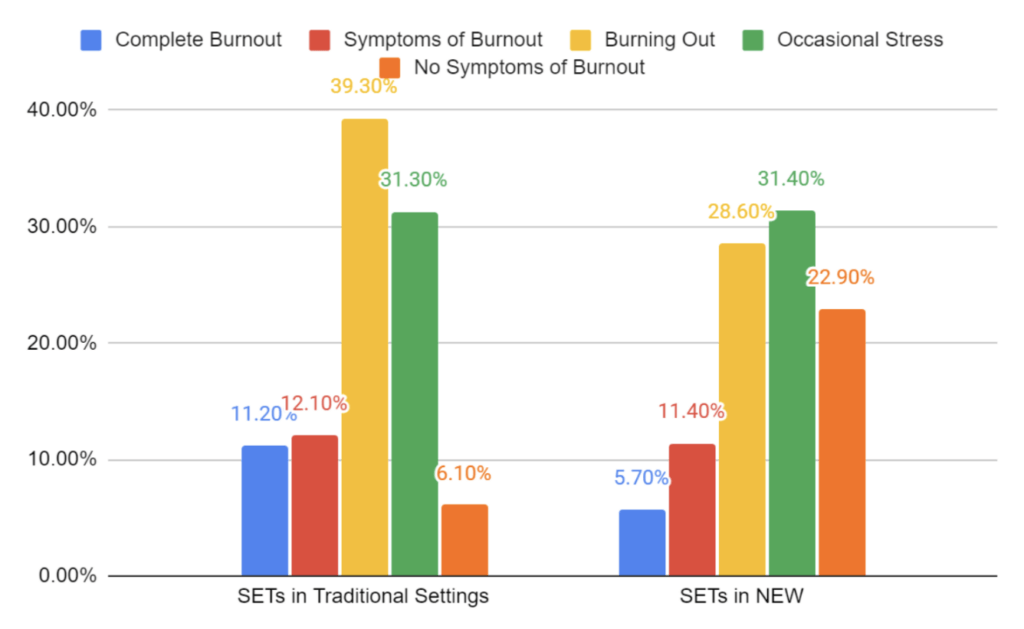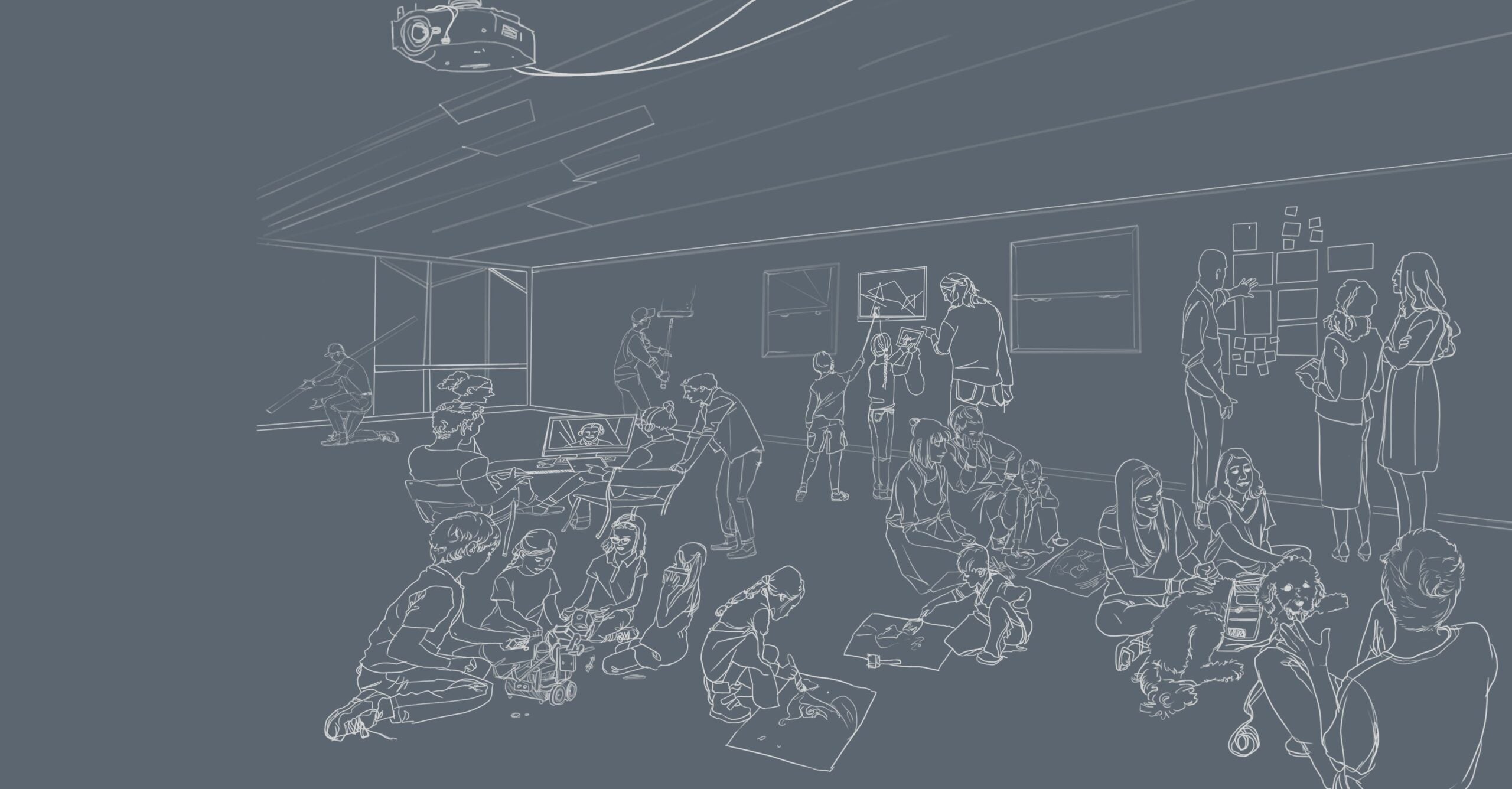At a glance
This study, conducted in the 2022–23 school year, aimed to examine the impact of team-based staffing models on the working conditions of special educators and their job performance. Key findings underscore the effectiveness of teaming as a strategy to integrate and enhance the role of special education teachers, yielding benefits for school leaders, parents, teachers and students alike.
Introduction
Special educators face a unique set of job demands that set them apart from their general education colleagues. Their teaching tasks are similar to other educators in the sense that they plan, instruct and assess. However, they also take on the role of case manager. In this role, they are responsible for overseeing both the administrative and practical elements of ensuring that Individual Education Programs (IEPs) for students receiving special education services are effectively implemented and met.
Given that most students with IEPs spend a considerable portion of their day in general education classrooms, extensive collaboration and coordination with general educators is essential. However, the isolated nature of their work and the lack of shared planning time with general educators can pose considerable obstacles for special educators to effectively perform their duties.
The role of a special educator can be exceedingly demanding. Empirical data show this group of educators experience a higher turnover rate and are more prone to transferring workplaces than their general education colleagues. According to the U.S. Department of Education (2023), shortages of qualified special educators exist in nearly every state, forcing districts to fill positions with less qualified personnel. With an increasing number of students receiving special education services and a lack of sufficiently trained special education teachers to serve them, there is a pressing need for schools to reevaluate and restructure how they deploy these educators.
Research indicates working conditions influence key elements of teacher turnover, such as job satisfaction and self-efficacy, which in turn can contribute to teacher burnout. Implementing team-based staffing models, such as those designed by the Next Education Workforce™ initiative, show promise for improving the working conditions of special educators. These models help to restructure special educators’ roles, supporting them to manage their complex workloads and become more integrated into the broader school community. Additionally, team-based staffing models may allow for greater inclusion of students with disabilities in general education settings.
Study Design
To better understand the experiences of special educators in team-based staffing models, we interviewed and surveyed teachers in the Mesa School District, a large Arizona district partnered with the Next Education Workforce initiative, to learn about their experiences. All told, 1,814 educators participated in the survey, of whom 260, representing 15%, were special educators. Additionally, 13 special educators and school and district leaders participated in semi-structured interviews.
Key Findings
Teaming fundamentally changes the IEP process
… because we’re teaming, we’re talking about it more. It’s easier to start getting data on those IEP goals. We’re starting to see the kids make more progress.
Mesa, Ariz., Next Education Workforce special education teacher
Developing and maintaining IEPs demands extensive coordination, collaboration and administrative work — a time-consuming process — to align support for students receiving special education services. As students progress into higher grades and encounter more teachers, the task of coordinating becomes increasingly complex. Special education teachers reported that being embedded in teams has led to a significant increase in interactions with general education teachers, making IEP procedures more manageable, increasing the likelihood of compliance and collaboration. Getting feedback and collecting data from teachers for the purpose of designing and implementing IEPs has become much easier. Additionally, teaming has improved the attendance of general educators at IEP meetings. This greater involvement of teachers provides parents with greater insight into their child’s educational needs and progress.
Teaming enhances special educators’ ability to advocate
I can say being on a team means they hear kids’ names regularly. We come up with individualized interventions weekly.
Mesa, Ariz., Next Education Workforce special education teacher
The siloing of special educators in schools limits their ability to advocate for vulnerable students on their caseload. These limitations are reinforced by the absence of common planning time with general education teachers. This structural separation can frequently lead to a “your student” mindset, where the responsibility for supporting students with disabilities is believed to fall on the special education teacher. Integrating special education teachers into team-based staffing models, along with the students they serve, promotes a shared sense of responsibility that helps bring about an “our kids” mindset. Teaming helps unite educators and encourages them to work together proactively to meet the diverse needs of all students. Special educators on teams report that they have been more effective in keeping students who are not meeting their goals in the spotlight, and ensuring that general educators are informed about critical aspects of students’ lives that may contribute to their challenges. These insights help to bring about an understanding of the needs of students and simplify the process of identifying supports in a timely manner. Special educators noted that working in team-based models helps to facilitate advocacy for students and highlighted that general educators have grown more aware of each student’s individual strengths and challenges.
Teaming elevates the role of a special educator
I feel like I can influence teachers enough that we can make pretty dramatic changes pretty quickly. That’s such fulfillment. I get to make a huge difference in kids’ lives.
Mesa, Ariz., Next Education Workforce special education teacher
Special educators working in team-based staffing models share a common planning time with general educators. As a result, they have the opportunity to share their expertise, especially in the area of inclusive practices. These opportunities equip general education teachers with specialized skills and knowledge, such as using Universal Design for Learning, that can then be implemented across the learning environment. This collaboration has helped general educators expand their knowledge of specialized pedagogies and improves special educators’ feelings of satisfaction because they feel fulfillment from the day-to-day impact they have on all students’ lives.
Special educators also report that increased collaboration with general educators has cultivated stronger relational trust and closer connections with their colleagues. Improved relationships have led to more purposeful and efficient discussions regarding teaching decisions. Special educators report that general educators increasingly see their role as crucial to how the team functions. Team members depend on special educators for their support, especially in critical situations where their expertise in social-emotional learning and classroom management is called upon. This interdependence and mutual trust within teams helps to elevate the role of special educators.
Teaming impacts the learning for all students
The strategies they get, the services they get, we actually just give it to everybody. They [students receiving special education services] don’t feel like they’re singled out or separated. I think that the biggest thing is giving, and sharing, and embedding true strategies into lessons …
Mesa, Ariz., Next Education Workforce special education teacher
Special educators feel that teaming makes co-planning, co-instruction and co-assessing more doable, leading to greater adoption of the use of co-teaching models. Special educators report that this approach positively impacts all students, not just those with identified special needs. This insight aligns with recent research showing that co-taught classrooms yield higher test scores for all students in standardized math and English assessments, regardless of ability.
Special educators report that even when they’re not teaching together in the same classroom with general educators, spending more time with their team helps improve how everyone teaches, especially how inclusive strategies are utilized. These inclusive methods eventually become a natural part of the team’s pedagogy, creating a learning environment where strategies traditionally used in special education are benefiting all students. Not only do general educators benefit from the exchange of strategies and knowledge, but special educators also report gaining a deeper understanding of subject area content, allowing them to support both students receiving and not receiving special education services.
Considerations during implementation
If integrating special educators into team-based staffing models interests you, here are four considerations to keep in mind when designing your models:
- Master Scheduling: Administrators and teachers identified two main challenges in incorporating special education into the master schedule when implementing teams. First, the diverse needs of students receiving special education services, combined with the inclusive nature of team-based models, can complicate coordination with service providers. Second, the requirement for special educators to fulfill the service minutes specified in students’ IEPs adds a layer of complexity to the scheduling.
- Staffing: Administrators noted the importance of team dynamics when forming effective teams that include special education teachers. It can be crucial for both special and general educators to share similar philosophies and approaches toward co-teaching, co-planning and co-assessing. Moreover, the current shortage of qualified special educators poses an additional challenge in how schools allocate resources.
- Transition Points: Administrators find that transitioning students between grades or school should be central, especially when incoming student’s IEPs aren’t aligned with the structure of teaming. For instance, students moving from a non-teaming middle school to a teaming high school may require a reevaluation and possible amendments to their IEPs, which may require starting the process early, typically at the end of the previous school year.
- Training: Teachers and administrators highlighted the necessity for training in Universal Design for Learning, Multi-Tiered Systems of Support and understanding of how to utilize co-teaching models. They emphasized that when embedding special educators in team-based models, they need to provide targeted professional development to maximize the effectiveness.
Implications for special education teacher retention
Addressing teacher turnover might be effectively tackled by addressing the professional isolation special educators feel by redefining their roles. Strategically restructuring school staffing and deploying special educators to include them into the wider school community and increasing collaborative opportunities with their colleagues, could be an effective method for improving teacher retention.
Evidence for this approach has begun to emerge, particularly from a recent teacher satisfaction survey conducted by the Next Education Workforce initiative in partnership with the Johns Hopkins University Institute for Education Policy. This survey compared the experiences of educators working in teams-based staffing models with those who are working in one-teacher, one-classroom traditional staffing models. In a secondary analysis, data indicated that working in team-based models was positively and statistically significantly associated with special educators’ perceptions of respect and their perceived access to adequate professional learning opportunities. Additionally, special educators on teams experience less burnout and symptoms of burnout than those not on teams, as illustrated in the figure below. Given that burnout significantly contributes to staff turnover, these results are encouraging. Future research should further examine how teaming impacts the experiences and working conditions of special educators*

*SETs not on a Team (n=225) and SETs on a Team (n=35)
Implications for inclusion of students with disabilities
Currently, 7.3 million or about 15% of all students in public education receive special education services. Despite the growing number of students requiring services, there has been a decline in the number of fully qualified educators, particularly in urban and rural areas where students from lower socioeconomic backgrounds encounter less qualified teachers. Strategic organization of educators, such as in team-based staffing models, could serve as an important method of distributing expertise so more students, particularly those historically marginalized, can access high-quality education. Moreover, teaming has the potential to reduce educational inequalities by allowing students to access support directly within their classes, expanding their access to their general education teachers and peers. As inclusivity for students with disabilities gains emphasis, the potential of Next Education Workforce team-based staffing models as a mechanism for inclusion should continue to be explored and tested.
Additional resources:
5 tips for creating an inclusive secondary school learning model


